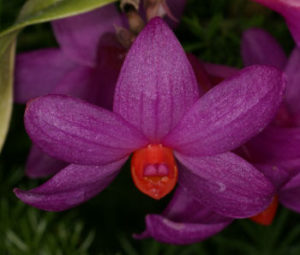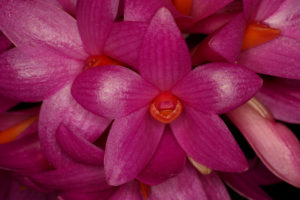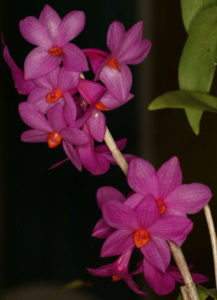The following article was written for the Orchid Species Bulletin published by the Orchid Species Society, which is based in Brisbane, Queensland in July 2012, and updated August 2025.
Bear in mind that any cultivation notes refer to the subtropical conditions of Southern Queensland, Australia.
 Chromatotriccum sulawesiense (Erfkamp & O.Grüss) M.A.Clem. & D.L.Jones was first described by Joachim Erfkamp and Olaf Grüss as Dendrobium sulawesiense Erfkamp & O.Grüss in Die Orchidée in 2000. The specific epithet comes from Sulawesi (island of Indonesia), and the Latin suffix –ense (origin), referring to where the type was collected.
Chromatotriccum sulawesiense (Erfkamp & O.Grüss) M.A.Clem. & D.L.Jones was first described by Joachim Erfkamp and Olaf Grüss as Dendrobium sulawesiense Erfkamp & O.Grüss in Die Orchidée in 2000. The specific epithet comes from Sulawesi (island of Indonesia), and the Latin suffix –ense (origin), referring to where the type was collected.
Jeffrey Wood (2003) and Howard Wood (2006) believe that Den. sulawesiense is synonymous with Den. glomeratum Rolfe. Howard Wood also believed that Den. glomeratum does not occur in Sulawesi. Phil Spence (2025) believes that the two taxa Den. glomeratum and Den. sulawesiense are distinct taxa, and are not synonymous.
Morphological and molecular studies show that the generic limits of Dendrobium need to be reviewed. Based upon these studies, Mark Clements and David Jones transferred Den. sulawesiense to the genus Chromatotriccum M.A.Clem. & D.L.Jones in The Orchadian in 2002. The authors did not make any reference to Den. glomeratum in that generic treatment. Mark Clements subsequently transferred Den. glomeratum Rolfe to Coelandria glomerata (Rolfe) M.A.Clem. in Telopea in 2003. There seems to be much confusion with several names that have been applied to two different taxa, which are superficially similar.
Plants of the World Online [POWO] treats Chromatotriccum as a synonym for Dendrobium. I prefer a consistent taxonomic classification of Orchidaceae, which does not rely predominantly on DNA and genetic information. Instead, I prefer to acknowledge ecology, pollination biology, breeding behaviour, as well as plant habit and floral characteristics. I recognise Chromatotriccum as distinct from Dendrobium.
The generic name Chromatotriccum was derived from the Greek chromatos (colour) and trikkos (small bird) for the colourful flowers that are often pollinated by birds. Chromatotriccum produce colourful flowers on short inflorescences from matured, generally leafless stems. The flowers have a tubular lip, which has a pursed or infolded apex and produces nectar at the base.

Cht. sulawesiense is an epiphytic sympodial plant, which produces long cane-like stems that are 25-60 cm long and 4-5 mm in diameter at the base and about 1 cm in diameter in the middle. The brownish grey stems grow for two years and eventually become pendent as they lengthen. They bear many thin dark green two ranked, leaves that are soon deciduous. The ovate-lanceolate to narrowly elliptic leaves are 5-9 cm long and 14-30 mm broad. When mature, the stems are covered with brownish-grey leaf sheaths that have dried after shedding the leaves.

Short inflorescences are produced from the upper nodes of the leafless stems. The inflorescence of Cht. sulawesiense carries 2-6 or more showy flowers in a loose cluster. Opening widely, the flowers are 3-5 (-6) cm across and have deep rose-pink to bright magenta-purple sepals and petals. The column and lip is a contrasting bright orange to orange-vermilion or red and is pursed or folded at the apex with an uneven toothed margin. The flowers have been reported to last for 7-10 days, but can survive for 4-5 weeks.
Cht. sulawesiense is distributed in Sulawesi and the Moluccas, where it is found in lower montane forests between 950-1,500 m altitude. Howard Wood (2006) says that this species does not thrive in cool conditions preferred by most species in this genus, nor does it tolerate drying.
A warm to intermediate-growing species, Cht. sulawesiense is best cultivated in a small hanging pot or basket with a well-drained medium. The long stems soon become pendent unless they are staked upright. Provide bright light, such as beneath 70% shade cloth, with high humidity and good air circulation. Water it regularly with a reduction in frequency during the cooler months. Plants should not be allowed to remain dry for long periods. I recommend a winter minimum of 12oC.
References
Baker, M.L. & C.O. Baker. (1996) Orchid Species Culture – Dendrobium. Timber Press, Portland, Oregon.
Clements, M.A. (2003) “Molecular Phylogenetic Systematics in the Dendrobiinae (Orchidaceae), with Emphasis on Dendrobium section Pedilonum.” Telopea, 10 (1): 247-298.
Clements, M.A. & D.L.Jones. (2002) “Nomenclatural Changes in the Dendrobieae (Orchidaceae) 1: The Australasian Region.” Orchadian 13 (11): 484-497.
O’Byrne, P. (2001) A to Z of South East Asian Orchid Species. Orchid Society of South East Asia, Singapore.
Spence, P. (2025) “Six controversially named Dendrobium species.” Orchids Australia, 37 (2) : 26-29.
Wood, H.P. (2006) The Dendrobiums. A.R.G. Gantner Verlag K.G., Liechtenstein.
Wood. J.J. (2003) “Dendrobium glomeratum.” Curtis’s Botanical Magazine, 20 (1): 161-171.
